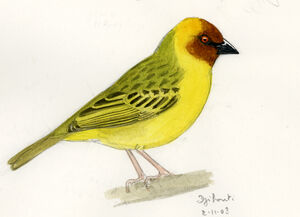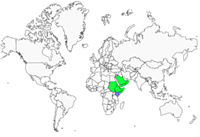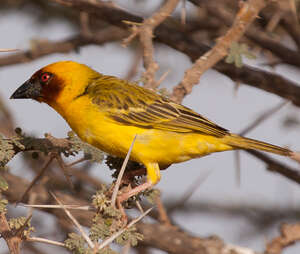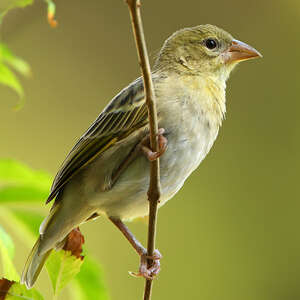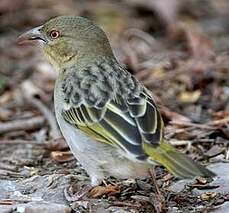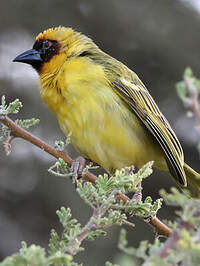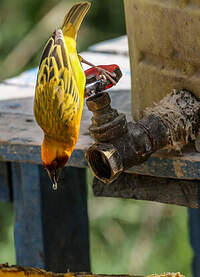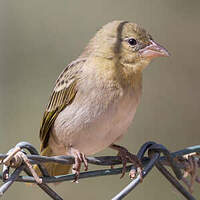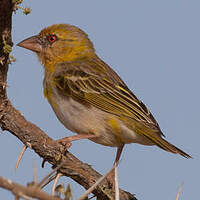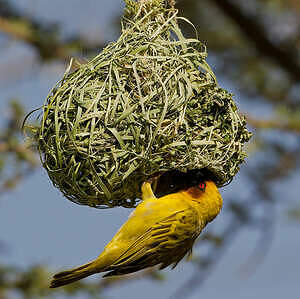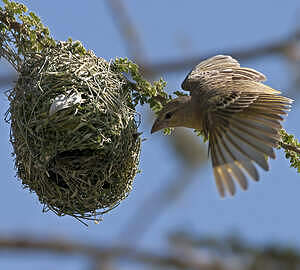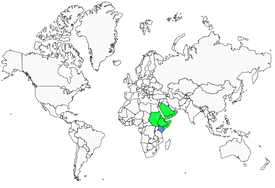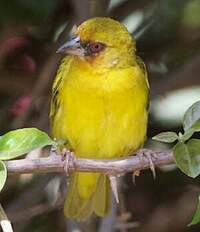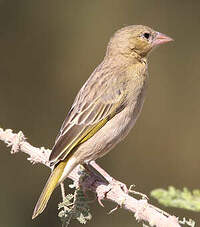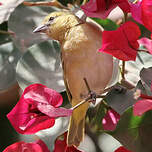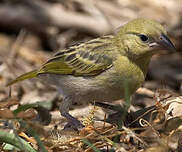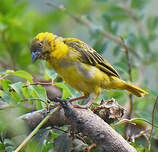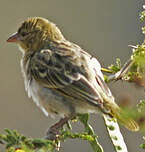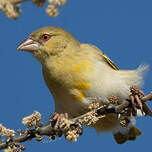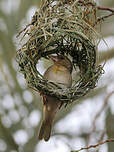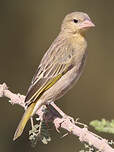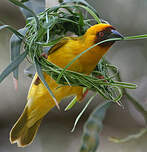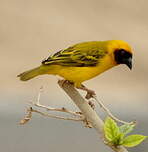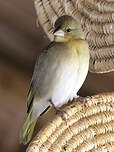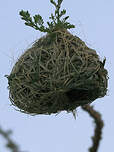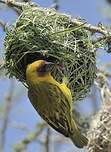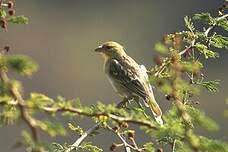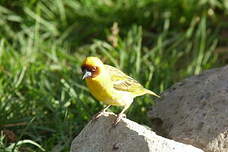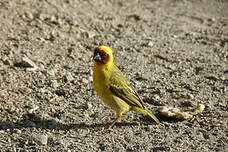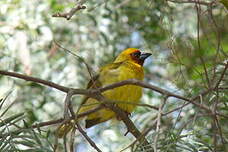Rüppell's Weaver
Ploceus galbula - Tisserin de Rüppell
Identification
Rüppell's Weaver is a medium-sized weaver with dimorphic plumage. As with many of these birds, the breeding male's plumage is predominately yellow. The head is bright yellow with a dark chestnut face surrounding the large black beak and including the distinctive red-rimmed eye. The chestnut may diffuse slightly to a yellowish hue in some males. The nape is tinged with green, transitioning to the yellow-green mantle and back lightly streaked with olive-brown. The rump is yellow. The tail and wing feathers are dark olive-brown, broadly edged with yellow. All underparts are yellow-buff. Legs range to flesh coloured. The non-breeding male is very different, resembling the female but distinct by its red iris. The female has nothing in common with the breeding male but morphology; she is slightly smaller. The head is a dull yellowish green and the dark eye stands out. A faint pale eyebrow can sometimes be seen, emphasized by a scarcely defined postocular line. The bill is pinkish-horn-coloured with the upper mandible slightly darker. No hint of a male's mask. The mantle and back are grey-beige and clearly streaked with blackish-brown. The rump is green-olive. The grey-olive rectrices have yellowish edges. The wing feathers are dark brown, bordered with yellowish in the remiges and buff in the tertials and coverts. The whitish tips of the darker median coverts form a fairly distinct wing bar. Underparts are dull white with a slightly lemon chest. The juvenile resembles the female but with a more ochre-washed chest. Its bill is pink. If male, he will first develop a faintly marked pale-chestnut facial mask while the chin remains yellow.
Subspecific information monotypic species
Foreign names
- Tisserin de Rüppell,
- Tejedor de Rüppell,
- tecelão-de-cara-castanha,
- Gilbweber,
- Rüppell-szövőmadár,
- Rüppells Wever,
- Tessitore di Rüppell,
- rödahavsvävare,
- Brunmaskevever,
- pletiarka savanová,
- snovač etiopský,
- Brunmasket Væver,
- oliivikutoja,
- teixidor de Rüppell,
- wikłacz rdzawolicy,
- Ripela audējputns,
- Иволговый ткач,
- キイロハタオリ,
- 栗脸织雀,
- 栗臉織布鳥,
Voice song and cries
Its usual call, a tchii or tchri, resembles somewhat the call of a sparrow. Its singing is a continuous gibberish made up of various notes, some screeching and unpleasant, others more melodic, all tied together by syllables resembling cries. At times, it can make one think of the song of the Common Rock Thrush.
Habitat
Rüppell's Weaver lives and reproduces in dry and arid environment. It can be found in savanna-type habitats, arid coastal plains, cultivated areas and its borders, wetlands, lake shores, parks and gardens, from sea level up to 2000 meters. The species is not migratory. The only movement seen is of probably nomadic individuals moving in the driest regions after the breeding season.
Behaviour character trait
Rüppell's Weaver is a gregarious bird. Groups of 10 to 20 individuals can be observed searching for food, but its African range has the most abundant numbers.
Groups of several tens of thousands of individuals can be seen in agricultural areas during the post-breeding season, which has consequences for farmers. It is willing to mix in with other passerines such as Streaky-headed Seedeater, Thick-billed Seedeater, Red-billed Quelea, or the Red-billed Woodhoopoe in search of food, and even in roosts.Dietfeeding habits
Reproduction nesting
The breeding season coincides with the rainy season. Rüppell's Weaver is a gregarious and colonial bird for reproduction. Colonies can comprise only a few nests, but can also hold up to 50. Intermediate Weavers, which are less gregarious, can also nest here, as in the Awash National park in Ethiopia, for example. A colony of Rüppell's Weavers includes more females than males. In fact, the male is polygamous and can own up to 3 females, but a male can also stay single and unemployed. The chosen site for the colony is often located above water. The hosting tree species are diverse, consisting of trees, acacias, eucalyptus, date palms (Phoenix dactylifera), tamarinds (Tamarindus), and in Saudi Arabia jujube trees (Ziziphus spina), as well as tall herbs such as sorghum (Sorghum bicolor).
The nest built by the male is spherical or slightly flattened and has several attachment points on thin branches. It is hung at a height of 2 to 6 meters from the ground, preferably above the water. Each male can build up to 8 nests. He is not afraid to tear down unoccupied nests. The nest is woven of herbs or long strips of leaves, for example from date palms, which the male carefully cuts with its beak. The inside is lined with vegetal down, feathers and leaves. The initial construction does not have an entrance tunnel, which is added later. It measures 50 mm in length. The female lays two or three white or blue eggs, which are highly spotted, sometimes only mottled with red. Only the female incubates for 14 to 15 days. Whereas in polygynous Weavers, the females do the main work of feeding the chicks at birth, in Rüppell's Weaver, the young are fed by the male by regurgitation while the female covers them.On the fourth day, the two adults feed the nest. At 18 days, the young leave the nest.Geographic range
Rüppell's Weaver's range is restricted to the Horn of Africa and southern Arabian Peninsula, covering countries bordering the Red Sea and the Gulf of Aden. A small, peripheral population occurs in southern Sultanate of Oman. The species has been introduced to Kuwait. Several subspecies described in the past are no longer valid today.
Threats - protection
Sources of information
- IOC World Bird List (v14.1), Gill, F and D Donsker (Eds). 2024-04-18.
- Birds of the Horn of Africa, Nigel Redman
- Hanbook of the birds of the world - Vol 15, del Hoyo J., Elliott A. Christie D.
- HBW Alive,
- xeno-canto, Sharing bird sounds from around the world,
Other sources of interest
 Specification sheet created on
20/07/2023 by Nathalie Santa Maria
Specification sheet created on
20/07/2023 by Nathalie Santa MariaTranslation by AI Oiseaux.net
published: 03-01-2020 - Updated: 11-01-2020
© 1996-2024 Oiseaux.net
- Accipitriformes
- Aegotheliformes
- Anseriformes
- Apodiformes
- Apterygiformes
- Bucerotiformes
- Caprimulgiformes
- Cariamiformes
- Casuariiformes
- Charadriiformes
- Ciconiiformes
- Coliiformes
- Columbiformes
- Coraciiformes
- Cuculiformes
- Eurypygiformes
- Falconiformes
- Galliformes
- Gaviiformes
- Gruiformes
- Leptosomiformes
- Mesitornithiformes
- Musophagiformes
- Nyctibiiformes
- Opisthocomiformes
- Otidiformes
- Passeriformes
- Pelecaniformes
- Phaethontiformes
- Phoenicopteriformes
- Piciformes
- Podargiformes
- Podicipediformes
- Procellariiformes
- Psittaciformes
- Pterocliformes
- Rheiformes
- Sphenisciformes
- Steatornithiformes
- Strigiformes
- Struthioniformes
- Suliformes
- Tinamiformes
- Trogoniformes

